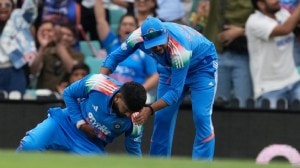Bringing up a baby elephant
When the big squalls curve to crash through Kodanad forest and the river is in an angry red spate, Velayudhan Subramanian would know he is going to have a baby.

When the big squalls curve to crash through Kodanad forest and the river is in an angry red spate, Velayudhan Subramanian would know he is going to have a baby. This monsoon the call came rather early, though. ‘‘You have a baby, Subramanian, a girl,’’ his bosses told him three days ago.
By evening, they had brought her to him, screaming weakly, pushing and shivering, in a jeep. A baby elephant, all of three months, bruised and wounded by the Chaliyar river a hundred kilometres away, a nail on her front leg wrenched off.
The currents had apparently seized her when the herd was crossing the rain-swollen river, and carried her many kilometres over the boulders and sand banks. Until a bunch of tribals on the river bank off Nilambur saw her tiny head and trunk bobbing on the waters.
They jumped in and rescued her, and then spent a whole day hiding away from her behind the trees, watching her stand there on the river bank weak, hungry and crying — and hoping her mother and the herd would come to take her back. That did not happen, and the tribals went to the forest officials ‘‘They know that if you handle a stranded wild baby elephant for too long or even try to feed it, the herd would never take it back once it detects the human smell. But the tribals knew she would die if she was not fed just then and alerted us,’’ says Deepak Mishra, Divisional Forest Officer.
From Nilambur, she was put in a jeep and sent to the Kodanad elephant camp— and more importantly, to Subramanian.
His colleagues say Subramanian looked up the bumps and bruises on her forehead and legs as soon as she came, took her to the temple near the camp, and got a puja performed for her life. He then gently took the baby elephant to one of the many kraals—a 20×15 feet teak log enclosure to keep elephants. This man is a descendant of generations of mahouts, and has known elephants from as far back as he can remember.
For the last three days, Subramanian has been sleeping, laughing and talking with his baby inside the kraal, day and night. ‘‘She is in great trauma, leaving her mother and the herd. She needs care, and she needs me,’’ Subramanian says. The still-frightened baby elephant would start wailing the moment he comes out the kraal, dashing her injured forehead against the bamboo rails that he fixed between the original teak logs—she is tiny enough to get out through the gaps. And once he goes back in, she would jiggle her head happily, nuzzle him all over, grab his neck with her trunk, even pull his lungi off, and keep him close to her.
‘‘I haven’t slept the last three nights since she came. She keeps waking up and climbs all over me, almost every half hour. She sometimes get scared and starts crying, and I have to hold her, talk her back to sleep,’’ says Subramanian, smiling through his three-day-old stubble. His baby has her own feeding bottle for milk, and is on a diet of ragi, Complan and ‘‘virtually everything else that you give a human baby,’’ besides antibiotics for her wounds and vitamins to help her fight stress.
This, he says, would need to go on for at least three more months until she could manage on her own.
This is the ninth baby elephant that the lanky, weather-beaten Subramanian is playing mother to. Two died, nine survived. All of them had reached him washed up by the rivers over the many past monsoons. He has no kids of his own, ‘‘but all these are my babies,’’ he insists, waving at the adjacent kraals. The one immediately left to his new baby’s kraal has Parvati, a one-year-old who had reached him last monsoon, now healthy and peering through the logs at the new comer. Subramanian has been doing this for about 25 years now—and is still a casual labourer with the forest department, earning Rs 140 for each day’s work.
All the other seven elephants in Kodanad have names, but DFO Mishra says he is deliberately not naming the new one yet. ‘‘It will break Subramanian’s heart all the more if we give her a name, which has a sentimental ring and means more personal attachment— and then she dies. We have the vets looking her up regularly, but you can’t do an X Ray or a CAT scan on an elephant for internal injuries. I would say she still has only a 50-50 survival chance.’’
Would she survive, you ask Subramanian. He stares back, eyes welling. ‘‘Would you ask that question about a sick child in your home?’’ he asks you back.



- 01
- 02
- 03
- 04
- 05




























